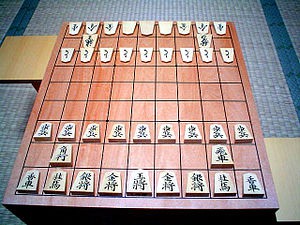Shogi (Japanese Chess)
Shogi, or Japanese chess, is the most popular of a family of chess variants native to Japan.
Objective
Technically the game is won when a king is captured, though in practice defeat is conceded at mate or when mate becomes inevitable.
[edit] Game equipment

Two players, Black and White, play on a board composed of squares (actually rectangles) in a grid of 9 ranks (rows) by 9 files (columns). The squares are undifferentiated by marking or colour.
Each player has a set of 20 wedge-shaped pieces of slightly different sizes. Except for the kings, opposing pieces are differentiated only by orientation, not by marking or color. From largest to smallest (most to least powerful), the pieces are:
- 1 king
- 1 rook
- 1 bishop
- 2 gold generals
- 2 silver generals
- 2 knights
- 2 lances
- 9 pawns
Several of these names were chosen to correspond to their rough equivalents in international chess, and not as literal translations of the Japanese names.
Each piece has its name written on its surface in the form of two Japanese characters (kanji), usually in black ink. On the reverse side of each piece, other than the king and gold general, are one or two other characters, in amateur sets often in a different colour (usually red); this side is turned face up during play to indicate that the piece has been promoted. The pieces of the two players do not differ in colour, but instead each faces forward, toward the opposing side. This shows who controls the piece during play.
The Japanese characters have deterred many people from learning shogi. This has led to "Westernized" or "international" pieces, which replace the characters with iconic symbols. However, partially because the traditional pieces are already iconic by size, with more powerful pieces being larger, most Western players soon learn to recognize them, and Westernized pieces have never become popular.
For more information on this, Visit Wikipedia.org
Information Taken from Wikipedia.org






